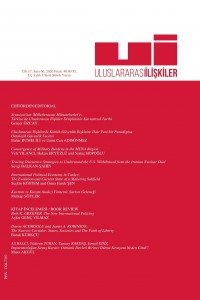Amerika Birleşik Devletleri’nin İran Nükleer Anlaşmasından Çekilmesini Anlamak Amacıyla Söylemsel Stratejilerin Ortaya Çıkarılması
Abstract
Söylem-tarihsel yaklaşımı analizine dayanan bu çalışma, ABD’nin nükleer anlaşmadan çekilmesinin temelini
oluşturan ABD-İran düşmanlığını yeniden üretmeye yönelik söylemsel stratejileri incelemektedir. ABD
Kongresi’nin ve Başkan Trump’ın İran hakkındaki söylemlerinin incelendiği bu makale, ABD’nin, pozitif özsunum
ve diğerlerinin olumsuz sunulması söylemsel stratejisine başvurarak, İran’a yönelik karşıt eylemlerini nasıl
meşrulaştırmaya çalıştığını göstermektedir. Tartışmalarını tarih, tehdit ve sorumluluk argümanları üzerinden
söylemleştiren ABD, İran’ı teröre destek veren bölgesel ve küresel güvenliği tehdit eden düşmanca bir rejim olarak
sunmaktadır. Çalışma, tarihsel koşullara bağlı olan bu söylemlerin ABD’nin nükleer anlaşmadan çekilmesini
meşrulaştırmak için kullanıldığını vurgulamaktadır.
Keywords
References
- .......
Abstract
Based on a discourse-historical approach, this study examines the discursive strategies used by the United States to
reproduce Iranian enmity that constitutes the basis for the U.S. withdrawal from the nuclear deal. Analyzing the U.S.
Congressional hearings and speeches delivered by President Trump on Iran, the paper shows how the United States
has engaged in legitimizing its antagonistic actions towards Iran by appealing to the discursive strategy of positive self-
presentation and negative other-representation. Basing its arguments on the topoi of history, threat, and responsibility,
the United States presents Iran as a hostile rouge regime sponsoring terrorism and posing a threat to regional and
global security. Emphasizing that such discourses are embedded within historical conditions, the paper highlights the
historical context and discursive strategies that the United States exploits to justify its anti-nuclear deal actions.
References
- .......
Details
| Primary Language | English |
|---|---|
| Journal Section | Research Article |
| Authors | |
| Publication Date | June 1, 2020 |
| Published in Issue | Year 2020 Volume: 17 Issue: 66 |


